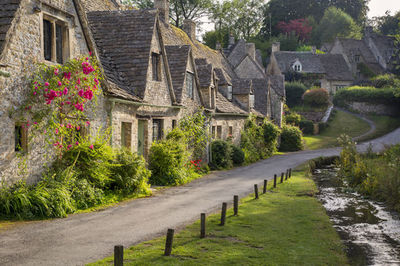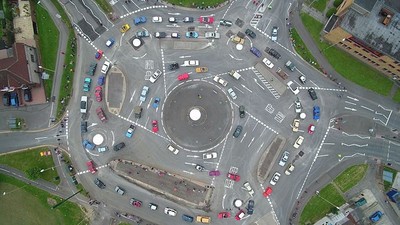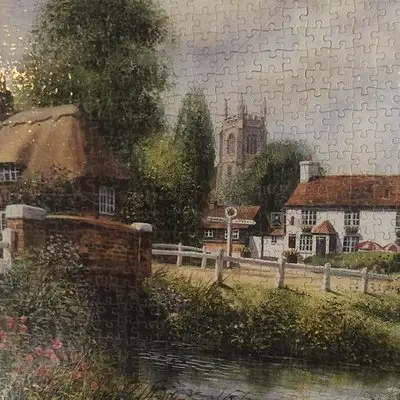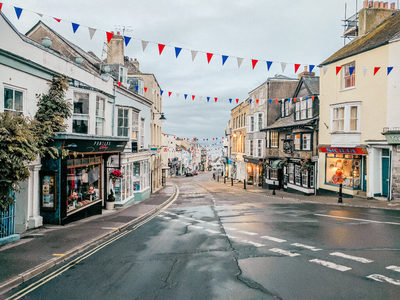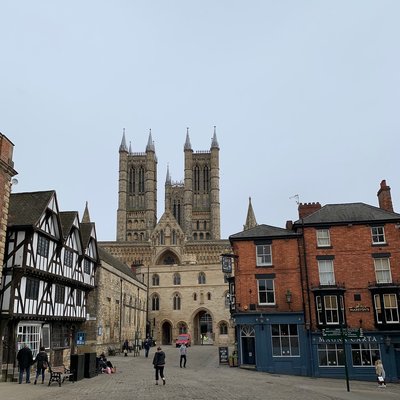GREAT DRIVES: ENGLAND OFF THE MOTORWAYS
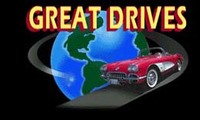 |
For Conde Nast Traveler Magazine
by Stephan Wilkinson
I HAVE A FRIEND who drives the biggest airplane in America--an
Air National Guard C5A flying warehouse. Quite happy steering
400 tons of aluminum and ammo back and forth to Saudi Arabia,
Somalia and Bosnia, Colonel Jim returned from a recent vacation
in the UK shaken. "Do not drive in England," he announced, his
hands trembling. "It's terrifying. We nearly died. Several
times. Many times. The roundabouts...God, the roundabouts," he
muttered.
Of course, I had to go drive in England, if only to prove myself the automotive superior of a man who makes a living flying a four-engined overcast, an act of which I am incapable. I'd even give myself a handicap: do it in midsummer, when the Dreaded Tourist jams the tiny roads and the drone of mosquito-motored VW Campers and underpowered saloons dragging snail-shaped house trailers is abroad in the land. England in August would be the ultimate test.
My only defense would be a four-square Volvo 850GLT sedan--the car the Swedes are trying to market as an antidote to decades of humorless suburbo-mobiles with reputations for appealing to Vermont poli-sci professors and Martha Stewart acolytes. If "sporty Volvo" is an oxymoron, the Roman roads and Norman lanes of England will quickly prove it. This, after all, is the country that invented the concept of car as toy.
DAY ONE: London to Midhurst the long way (105 miles)
Why do the English drive on the wrong side of the road--the trait that so unnerved my pilot friend? Because the drover's whip was in his right hand, so horse-drawn vehicles always had the commander on that side, the better to whack his powerplant. The English, obedient to tradition, did the same with their cars.
It's the first characteristic of British motoring with which you'll have to make peace. Some never do: Colonel Jim several times tried to enter roundabouts--traffic circles--with right turns. Not a good idea, particularly since the English tend to attack their roundabouts like sneakers loose in a spin-dryer.
If you're stopping to see friends, as I was, getting directions
is also part of the charm of traveling by road in England.
It's never as simple as, "Second left past the Texaco station,
number 24, red house on your right." Some actual directions I
was given: "Past the white stones on a lawn, a turning beyond a
boxwood hedge." "Hard by a lime tree in a triangle." "The sign
says Slindon, but you won't see it, because it's obscured by
foliage." "Near a pub that used to be the Red Lion, but I don't
know what it's called now." And the Brits don't number their
houses, they name them: Marlborough House. Flinders. The Vetch.
Menhirs. Lovely, unless you're trying to find the damn thing.
Brian and Carol Leversha live in remarkably rural Dogmersfield, barely 40 miles outside London. We lunch on Cornish pasties at a breezy table outside their cluttered mobile home while Carol tries to keep the goats from eating the roses. I've seen so little traffic that I wonder, do they get many tourists in this bucolic shire? "No, there's nothing famous here except us," Brian laughs. He was the unfortunate flight engineer of a 747 that embarrassed British Airways by committing a very late, very low, very public go-around at Heathrow four years ago. Leversha was cashiered and will never fly again. Today, he and Carol tend to 150 angora goats and sell mohair.
"There was Catherine of Aragon, of course," Brian adds. "She met Arthur, Henry VIII's younger brother, just down the road there. Of course, Arthur died young, didn't he? And then she married his brother Henry, who had the marriage annulled when he met Anne Boleyn. It's complicated." That's England: wherever you turn, the immediacy of history comes as a series of small but constant shocks. Here Catherine flirted. There lies Isaac Newton. Here's Stonehenge. There the Industrial Revolution began.
Farnham: a town that looks as though it should be miniaturized and made of pottery, on sale at some crafts fair. The A287 south of Farnham is a lovely road between high hedgerows that are being riffled by a brisk breeze. The roadside vegetation itself is so close to the Volvo's flanks that it has been shaped and tunneled by the passage of cars, carved by fenders and bumpers yet constantly trying to take back its own.
Sussex, farther south, is hillier and more wrinkled than I'd expected, and some B-road detours and forays take the Volvo and its tromboning exhaust note into dark forest mysteries, ferny vales, green tunnels, goblin woods. There's hardly a sign of civilization other than the orderliness of even the forest: second growth? More like twentieth.
My destination is the Spread Eagle, an ancient hotel in Midhurst. ("Have a pint for us in the lounge bar," Brian had said when he'd recommended it, "and ask for one of the four-poster rooms.") Its floors are little more level than the heaving deck of a man 'o war, its timbers the size of small coffins. Everything lists and creaks like a fun-house.
On a wall in the lounge bar, when I go for my pint, is a small, framed page from the inn's 1939 "Alien's Register." Von Ribbentrop, then still ambasssador to England, has signed in. with him is Hermann Goering, who has come down to Sussex to choose his post-invasion headquarters. He fancies Lady Muriel Loder's Leonardslee, near Horsham. But he hasn't yet reckoned with the terrible twins--Spitfire and Hurricane.
DAY TWO: Midhurst to Salisbury (90 miles)
I'm heartened to see that on some of these narrow roads, the rocks have scars where even the Brits have had trouble getting through the corners. Here and there, I also notice small signs reading, "Boot Sale Saturday." Surprised to learn that the English are so heavily into footwear, it takes me awhile to figure out that a boot is a car's trunk, and a boot sale must be the British equivalent of a garage sale.
Approaching the cathedral city of Winchester on the A272, the land becomes a series of enormous, rolling, sere hills of mown hay, its dun color a strong contrast to the lush green. The placidity of the country, the tiny townlets, these curiously neat yet ancient roads is overwhelming, at the same time baffling. Where are hidden all the ills and upheavals that we all must suffer? How do the English manage to make this a land of such orderliness and superficial perfection?
Cathedrals too often seem gloomy, heartless places, but Winchester's is alive, joyous. The organ peals on a Tuesday morning, an exhibition of modern sculpture is in progress along-side the presbytery, and there is a wonderful light so unlike the waxy gloom of Catholic basilicas. Unfortunately, my brain is perfused with the New Vaudeville Band's awful 1966 megaphoned refrain, "Win-CHES-ter Kuh-THEE-drull, da-da-dum-da-dah..."
At the entrance to the library, a chirpy, gray-haired lady--English cathedrals seem to be run by chirpy, gray-haired ladies--is trying to determine whether two young German tourists are legitimately students or simply unemployed. "You only have to pay 50 pee if you are a student...well, I'll deal with you in the meantime," she says to me. "You're obviously not a student. But are you a senior? One hates to ask, but one hates to see visitors pay more than they must." Listen, lady, one hates to admit being a senior.
The glory of the cathedral is its 12th century Bible. Two hundred and fifty calves gave their skins for its vellum, and gold and lapis lazuli gleam from those pages. Yet this is a cathedral not of ostentation and gilt bought upon the bodies of the devout but of austere beauty and architectural majesty.
DAY THREE: Salisbury to Northleach with a stop at the beach (213 miles)
Salisbury's cathedral, a short poke down the A272, offers the most legible of the four original copies of the Magna Carta--a small, closely written document about twice the size of a legal-page memo. "Oh, yes, people are surprised," the attendant says, "They expect it to be a book." No illumination, no fussiness, no filigree. It is obviously filled with boilerplate abbreviations, for the full translation is nearly 12 pages long. This, history's first detailed charter of specific human rights, spells out such basic demands as, "No widow shall be compelled to marry so long as she prefers to live without a husband." And some less admirable privileges as well: "If anyone die indebted to the Jews, his wife shall have her dower and pay nothing of that debt."
If I am to find the Dreaded Tourist--a creature hardly yet
in evidence inland--I'll have to head for the sea, on the A354
and then a series of tiny B-roads to Lyme Regis. It's not an
idle choice. Thirty-four years ago, I stood on the deck of a
grimy Liberian Liberty ship, a frightened seaman, and stared at
the twinkle of this coast from our anchorage in Lyme Bay. We'd
been spit out of the Bay of Biscay by a raging winter storm and
were pausing to catch our breath, but there would be no shore
leave.
Such a wonderful name for a town, it must be beautiful. Besides, isn't this where they filmed The French Lieutenant's Woman, a wonderful name itself? Lyme Regis turns out to be a corrugated Cape Cod, a wrinkled Provincetown, straggling up and down the walls of a river-carved gorge to the sea. There are day-trippers everywhere, and on the seafront, small boys are shrieking and frisking on stony mudflats while old men with their trousers rolled wade in the chilly water. Going to the beach in England is a bit like skiing in Michigan: possible, but why bother?
Northbound to Northleach on the M5--one of the few times I'll use England's superhighway system--the Bristol Channel comes into sight near Burnham, and then the River Severn. The tides must be enormous here, for the mouth of Shakespeare's Avon is nothing but a mud-wallow, small boats marooned far up its banks like abandoned toys.
It's evident everywhere, but particularly on a motorway: England has decided its police have better things to do than run revenue-directed speed traps. (I will see but one side-of-the-road police cruiser in 1,100 miles.) Traffic sets its own pace. Though the ostensible motorway speed limit is 70 mph, 80 to 90 is far more common, and I even take the Volvo to an indicated 129 for a brief burst. Lane discipline, a concept unknown in the U.S., is superb: the passing lane is utterly reserved for fast movers, and flashing lights and tailgating worthy of a NASCAR draft await the dawdler who ventures there.
Roadside-signs quiz: If Chipping Sodbury and Chipping Norton are towns, is Loose Chippings another one, or is it a Brit warning to watch out for gravel? For extra points, translate "Queues likely on slip road."
DAY FOUR: Northleach to Shrewsbury along the Welsh border (130 miles)
England is a series of dazzling stage sets, for architectural styles differ rapidly and specifically from shire to shire. We've left behind thatched roofs, and redbrick is yet to come. Now it's curtain down on the Cotswolds' slate-like roofs and enormous walls of tile-tight limestone, curtain up on the half-timber homes of Herefordshire. It happens about as fast--almost as though it's illegal to build stone houses west of Gloucester.
Hereford is the town that gave us "heifer" as a generic label for cows. (Is there also a city called Little Dogies?) The River Wye meanders through it, luminescently green weeds waving in the current like mermaids' hair. In the center of the town is All-Saints Church, its high spire bent at the top like a taper too long in the sun. The church was built on soggy ground and slowly tilted. Six hundred years later, when it came time to renovate the pinnacle, it was repaired in the true vertical rather than perpendicular to the plane of the tilted church.
"Are you a Herefordian?" an old man asks me as we both peruse the town map in the square.
"No, a New Yorker."
"Gawn. I've lived here 70 years."
"And you're still lost?" I laugh.
"No, there's a pub somewhere, has a marvelous painting of the SAS in action in Malaysia, but I can't remember where it is. They changed the name, I think. And how are you finding England?"
We shuffle slowly across the square while he narrates. "They beheaded a Welshman right here," he points. "He came out of Wales to be king--what was his name?--and they fought a battle 20 miles north of here. He hid in a cellar, but they found him and cut his head off. Well, I've got to pay my light bill. Have a nice time in England." Whether it's Catherine of Aragon or a nameless Welsh pretender, the English tend to talk about these things as though they'd happened last week.
He stops, turns back. "Go see the Mappa Mundi. I haven't done so myself, but it's said to be quite magnificent."
The Mappa Mundi, it turns out, is one of the four oldest maps of the world in existence, and it is on display in the spireless, truncated Hereford Cathedral. And that is part of the unparalleled pleasure of traveling in England: stop for lunch in a town because it has the same name as a cow, and you discover a wonder of the world.
The map indeed is magnificent, though apparently not intended for navigation: the copyist has transposed the labels "Europe" and "Africa." Nearby is what seems to be the grave of one Alexander Denton, his wife Ann and their stillborn baby. She died in childbirth in 1566, at the age of 18, and effigies of the three recline atop the bier in graceful death. Nice try, Alec: in fact Denton remarried and is buried in Buckinghamshire with his second wife.
Curtain down, curtain up, suddenly it's Shropshire: rolling pasturage with toy sheep and cows high above the road, which winds between high boxwood hedges that look as solid as stone. And the views from the heights, when attained, are almost incomprehensibly beautiful: a groomed patchwork of farmland and pastures, golden mown fields and tiny villages. Ralph Lauren tries to bottle the essence of this, and you can see why.
I'm torn between stopping to look and continuing to leg it along these sinuous roads, for the Volvo has made me a believer. Initially a bit contemptuous of its sporting pretensions, I've learned that under its conservative shell lives the best Volvo ever built. The handling is near-neutral, and I'd defy anyone to guess that the 850 has front-wheel drive. The five-cylinder engine is creamy-smooth, and the car's acceleration, braking, road-holding and top-speed performance numbers are much the same as those of the benchmark BMW 325, which also has a 2.5-liter engine, albeit of six cylinders and rear-wheel drive. (Further considerations: the BMW is several thousand dollars more expensive and has substantially less rear-seat room, but it also has a sportier aura, a vastly better manual transmission and a slightly higher top speed.)
The friend I'd stopped to visit in Northleach had shunned the 850--"Very nice, but not my style. The image is very much The Landowner," he'd laughed, turning back to the muddy Land Rover parked in front of his enormous stone house--and certainly image is the Volvo's challenge. Saab blundered upon a sporting cachet unbidden, first with its Turbo models; can Volvo simply announce that it is modish while wearing the same traditional clothes?
DAY FIVE: Shrewsbury to Lincoln (186 miles)
There must be a plentiful supply of cradles labeled "Birthplace of the Industrial Revolution," but one of the more memorable is the Severn Gorge just south of Telford, near Birmingham. Iron foundries, chinaworks, blast furnaces, steam engines, brickyards, coal mines...in the 1790s, this narrow stretch of river, no wider than a motorway, was the most industrialized area in the world. What began here forever transmuted England from an agrarian economy into "the workshop of the world."
Narrow as it was, the deep river had to be bridged, and at the town of Iron-Bridge, in 1780 they built the world's first cast-iron span, a splendid feat for a day when Manhattanites were still chopping down forests and shooting wolves. Today the gorge is a museum--half a dozen different museums scattered throughout six square miles, in fact--and what must once have been a roiling, fetid, festering sump of coal smoke and sewage, slaughterhouses and furnaces is today a quaint riverside park, a kind of engineering Williamsburg. The Severn, deep and muddy-brown, whorls and eddies like a miniature Amazon, and it's hard to imagine it once nearly paved with boats and barges.
The A5--once it was Watling Street, from Telford all the way to Hyde Park, 150 miles away in London--is a two-lane that roughly parallels the M6 and M1 motorways. Obviously, nobody would be stupid enough to actually use, so I do. The A5 turns out to be a straight, fast, virtually empty slice across Staffordshire farmland quite out of sight of the Midlands industrial wasteland, Iron-Bridge's legacy.
"Is it true that your speed limits are only 55 miles an hour?" asks the barmaid at the Bell Inn, where I stop for a pub lunch. ("A noted ham 'n eggery," its sign boasts. Unfortunately, I order beef curry--India's revenge on the Raj.) The English are fascinated by our highway dawdling, and those who have traveled in the U.S. regale friends with accounts of enormous housewives sawing at enormous steering wheels while they drive enormous cars so slowly they can do their makeup in the rearview mirror.
The Brits may be faster on the road, but they're also ruder. In fact, they may be the rudest drivers in the world. The concept of merging traffic or of the polite "After you, Alphonse" is literally foreign to them. Perhaps it is genetic--the motoring equivalent of the queuing mentality--but if you miss a signpost, fail to spot directions to a turning lane or are simply waiting on a side road to join a solid line of traffic, they'll hang you out to dry. And don't try the American technique of gesturing, signaling or inching your fender into line: the English will simply drive into you, for it is inconceivable to them that anyone would jump a queue.
It happens to me in Melton Mowbray. Twice I miss the proper lane for a complex turn onto the B676 toward Lincoln, and twice, when nobody will let me switch lanes, I am condemned to another entire lap of town on its one-way streets in treacly five o'clock traffic. (It's tempting to release a flurry of obscene gestures through the open sunroof, but I have a friend who badly broke his middle finger when he tried it in his VW Beetle on the Autobahn and hit the roof instead.)
DAY SIX: Lincoln to Knaresborough via York (117 miles)
Cathedral bells are probably the most imperfect way to make
music this side of rap, and those of Lincoln Cathedral are filling
the thinly sunlit air with their Medieval dissonance. They
are computer-controlled, I learn during a guided hike up the 300-odd
tiny, pie-slice steps to the very roof of the spire. In
1980, the ringer reached his eighty-fifth birthday and said the
hell with it.
Far below, the cathedral roof has an obvious kink of three or four degrees. Surveyors laying out the peak during a renovation based their calculations on sun-sights, the red-haired young guide tells me. "Unfortunately, they forgot to take into account the fact that during the process, the Julian calendar was superseded by the Gregorian, and there was 11 days' difference between the two. Of course, others say that it's because the devil can't walk a crooked line, so that keeps him out of the cathedral," she says.
"If you're looking for tourists, go to York. But frankly," she sniffs, "I think their cathedral is a bit out of proportion, really. The spire is too short."
She's right about York, though: not a single hotel room is available at any price in or near town, the tourist office tells me, and the sidewalks are flooded with gawkers, the streets packed with tour buses. I flee without so much as a glance at the squatty spire, idly choosing the A59 west to...oh, how about...Knaresborough. That sounds nice.
Indeed it is. Knaresborough turns out to be a fetching old Yorkshire market town tumbling steeply down the wall of a gorge above the River Nidd, a lovely stream full of holiday rowers and a flotilla of ducks. The ruins of a 14th century castle overlook the Nidd and a shallow waterfall, the walks and parapets beflowered, hedged and neatly trimmed. On the vivid, close-cropped green within the ancient keep, a young couple are playing lawn bowls. It could be a cliche, but that's England.
And this, ultimately, is the greatest joy of driving in England, no matter what Major Jim might think, no matter how obstinate the yobbo in the next lane might be, no matter how many times you have to tell yourself "look right, turn left." It is the serendipity of finding such beauty, such pleasure, such tradition and history at the end of each day seemingly no matter where you go.
Tomorrow I'll awake with that hit-the-road excitement that any driver with a sporty car, an open map and a destination not yet chosen knows so well. It's in many ways the best part of a Great Drive day, knowing that in fact the best is yet to come.
Let's see...how about we head down toward some of these nice B-roads across the Norfolk Broads...maybe stop at the Battle of Britain Memorial Flight hangar at RAF Coningsby, see their impeccably restored Spitfire...lunch at King's Lynn, that's a nice name for a seaport...make Bury St. Edmunds by teatime....
I'll find the best road of the trip, the B1225 south across Lincolnshire, an undulating, untrafficked two-lane that turns out to be one of those rare, comfortable, 90-mph country roads where a driver can indulge without bothering or endangering anyone, and I'll end up in an ancient cathedral town that--as happens throughout England--presents me, ever the aviator, with a small jewel of more modern history as well.
The foundations and remaining walls of Bury St. Edmunds' old Norman abbey, sacked in 1327 by townspeople tired of an overreaching church and its monastic fist, are today a series of vivid gardens. To one side is a quiet, fragrant English rose garden dedicated to the men who flew for the American 94th Bomb Group, four squadrons of which were based at Bury St. Edmunds' airfield in World War II. Among the traditional wooden benches is a single one of dull, oxidized, free-form aluminum, an Art Deco-ish imposter in the garden. It was given to the city in 1945 by the U. S. Army Air Force, obviously fabricated by armorers and fitters from parts of a used-up B-17. One of my dearest aviation mentors flew for the 94th. Perhaps it was the flesh of his old bird, the Eustace Tilley.
Amazing, the things you find in England.



